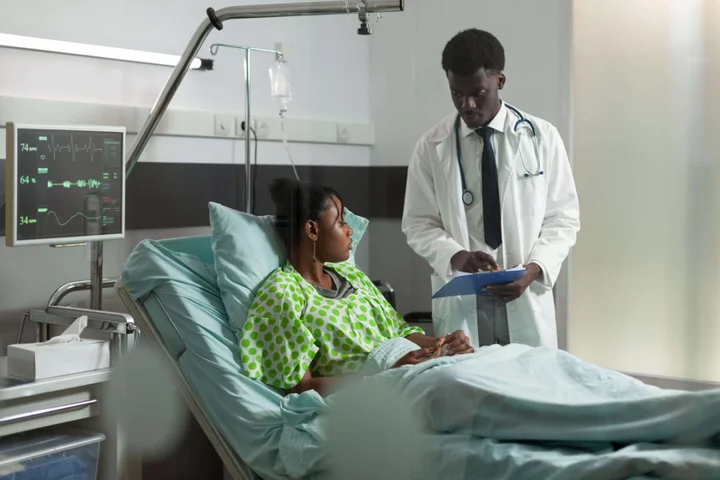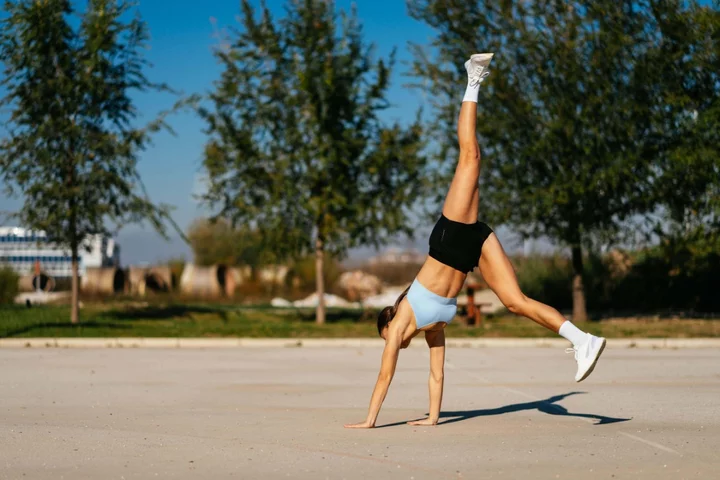
Sickle Cell Awareness Month: What is sickle cell disease and how do you know if you have it?
Almost 300 babies are born in the UK with sickle cells every year, according to the Sickle Cell Society, and the effects of sickle cell disease are believed to impact thousands. Yet, many people may not even know what sickle cells are or what living with the condition means. What is sickle cell disease? In most people, red blood cells are disc shaped and move easily through the blood vessels. But if you have sickle cell disease, your red blood cells are shaped like a sickle (similar to a crescent moon). This stops them moving with ease through the body and blood flow becomes restricted. Sickle cell disease isn’t actually one specific disease – it refers to a group of conditions affecting people with sickle cells, which range in severity.The conditions are inherited and predominantly affect people from African and Caribbean family backgrounds. What are the symptoms of sickle cell disease? Symptoms begin early in childhood and can sometimes be debilitating. How each individual is affected may vary, but the main symptoms are anaemia, an increased risk of infections, and pain. This includes extremely painful episodes called ‘sickle cell crisis’, which happens when blood flow to certain parts of the body become blocked. According to the NHS, these episodes can last for days and require hospitalisation. Other issues are associated with the condition too, including problems with the lungs, delayed growth in childhood, higher risk of stroke, leg ulcers and sight/vision problems.How is it diagnosed? Sickle cell disease is usually picked up during pregnancy or shortly after birth, although a blood test can be given at any time to see if someone has the condition or carries sickle cell genes. In parts of the country, pregnant people will be offered a test to see what the chances are of their child having sickle cells. Infants can be checked for the cells through a heel prick test.How do you treat it? Treating sickle cell disease is usually a lifelong process to help people with pain and to stay as healthy as possible. Treatment takes place in specific sickle cell centres and those living with it are encouraged to take care of their health, no matter the severity of their symptoms. Managing pain is a huge part of treating sickle cell disease. Staying hydrated can be helpful, as well as avoiding sudden temperature changes, like getting into a cold shower or diving into water. According to the NHS, Hydroxycarbamide (hydroxyurea) may be recommended, which is taken as a pill once a day. This can lower the quantity of other blood cells and requires careful monitoring, however. Some people may also be able to have a medicine called crizanlizumab, either on its own or alongside hydroxycarbamide, usually injected into a vein every four weeks. To prevent infections, many people with sickle cell disease will take daily antibiotics. Read More Charity boss speaks out over ‘traumatic’ encounter with royal aide Ukraine war’s heaviest fight rages in east - follow live TikTok has gone wild for adult gymnastics – here’s what you should know Man explains why he swapped veganism for raw meat diet: ‘I feel great’ Rugby star Ugo Monye: Boarding school shaped my career and my personality
2023-08-31 14:55

TikTok has gone wild for adult gymnastics – here’s what you should know
Have you always wanted to be able to do the splits or a backflip? Maybe you’ve watched your kids do a gymnastics class and thought, ‘Wow, that looks so fun’. Adult gymnastics is gaining some serious popularity online, with the TikTok hashtag #adultgymnastics getting over 209.5 million views. Influencers such as Anna Archer – who has over 300,000 followers on Instagram and creates content surrounding lots of different fitness experiments – and stunt woman Corinne Nicewick have shared clips of their experiences of trying out gymnastics as an adult. Nicewick, despite being a talented stuntwoman, has shared clips of how challenging she has found the sport, with viewers finding her attempts both funny and encouraging. Gymnastics has put some famous faces in good stead for other fitness-related challenges, with gymnast Beth Tweddle winning the 2103 series of Dancing on Ice and Ellie Downie, GB gymnast taking on the gruelling SAS: Who Dares Wins reality show in 2023.So, what do you need to know before you get involved? How does adult gymnastics work? Can anyone do it? Classes have been steadily cropping up across the UK encouraging adults of all abilities to get involved in gymnastics, and unless you have a health problem or injury that may restrict you from doing so, anyone can get involved. It is not so dissimilar to exercises you may already do like plyometrics (explosive body weight resistance exercises like box jumps), CrossFit or yoga. “Gymnastics is a series of different exercises that test your strength, mobility, flexibility and agility,” says Sofia Zolobova, instructor and gymnastics expert at Gymbox. “It’s also a lot of fun, incorporating lots of different floor, beam and hoop exercises,” she explains. This element of variety can bring a more fun, playful element to your workout routine. What are the health and wellbeing benefits of adult gymnastics? Gymnastics will give your body a really different workout and improve your strength, mobility and balance. “Strength and mobility are both very important as we grow older,” says Zolobova. “Gymnastics uses your own body weight, so not only do you get stronger, you move better. For example, to be able to execute a hand stand you need great shoulder mobility,” she explains. “With our modern tight shoulders, gymnastics can be helpful in improving our posture.” How do you get past being scared? As a kid, doing a cartwheel and taking a tumble doesn’t seem so threatening, but as adults we are all a bit more scared of getting hurt. Instead of falling into the trap of fear, embrace the playfulness of it. Zolobova says: “It’s a really fun way to exercise. It includes handstands, cartwheels and frog jumps, letting you unleash your inner child. It empowers you to do cool tricks as an adult and work up to a certain goal. It’s also a great fear fighter – sometimes you just have to let go and trust yourself.” What should we be careful of in adult gymnastics? Your fitness and flexibility may not progress as quickly as they might have done as a child. “Children are naturally more flexible than adults, so when undertaking gymnastics for the first time keep this in mind. Take things slow and one step at a time – you can always build up strength and flexibility with consistent practice,” explains Zolobova. How do we protect our backs and joints? Putting your back out or hurting your joints is a very real fear as an adult. Zolobova says: “Stretching should never be skimped on and should be thorough and dynamic [involving movement]. It’s also very important to make sure the body is warmed up before undertaking any gymnastic moves, a light jog and jumping jacks are great ways to get the muscles warm fast.”
2023-08-30 21:55

How can I improve my teenager’s low mood?
If there’s one thing associated with teenagers more than anything else, it’s moodiness. But although low mood is extremely common in teens, what’s just as common is that parents don’t know what to do about it. Adolescence is the highest risk period of life to experience depression, and half of adult mental health disorders start before the age of 15, says consultant clinical psychologist Dr Beth Mosley, who provides specialist mental health support to children and their families. “Seeing the signs of low mood in your teen can be worrying if you’re a parent,” she says. “The questions you may ask are likely to be, what are the usual highs and lows of adolescence, and what is something to worry about? Why might my teen be struggling with low mood, and most importantly, what can I do as a parent to help if my teen is feeling down and showing signs of disengaging with life?” Mosley, the author of new book, Happy Families, which is about the most common issues affecting children’s mental health and how parents can help, says although everyone will, at some point, experience low mood, sadness, irritability and loss of interest in things they enjoy, usually such feelings are linked to problems in life. But changes associated with puberty, and brain restructuring, mean adolescents are especially vulnerable to mental health problems, says Mosley, who explains: “These changes increase the possible impact of life stressors and, thus, their vulnerability to mental health difficulties. “The brain changes in adolescence mean teens feel emotions more intensely – both the highs and lows – meaning it’s not unusual to see them experiencing waves of low mood, particularly in the face of challenges.” She says if a teen’s low mood doesn’t go away, and prevents them doing the things they need to, like schoolwork and spending time with others, it would be wise to consider seeking help. The teen’s school may be able to suggest local support. But she adds: “Whether your teen experiences passing or more persistent low mood, the good news is that the brain is flexible and ripe for learning in adolescence, so there’s a lot we can do to support our teens when they’re experiencing low mood. “Importantly, this support will likely improve your relationship with your teen, and help protect them from developing mental health difficulties in adulthood.” If your teenager’s mood is low, these are the things Mosley says might help them… Encourage them to do what’s important to them When someone feels low, they tend to do less of what’s important to them, meaning they get less rewards from life and feel lower, Mosley explains. This is the low-mood cycle. Conversely, by doing more of what’s important to them regularly, they get more reward from life and start to feel better – this is the feel-good cycle, she says. So rather than a teen waiting until they feel better to do the things that are important to them, low-mood teens should do them now to break the low-mood cycle. “Determining what activities they can do more of and what unhelpful activities to do less is a key first step,” says Mosley. “You can support your child by providing more opportunities to do what’s important to them and increasing access to rewards. Give them practical support to do the activities they enjoy, provide encouragement.” Communicate better with them Mosley says that low mood can make it difficult for teens to communicate, but parents learning key communication skills can support how they communicate with their teens and, in turn, help improve their mood. She says being careful how you say things, through tone of voice and nonverbal body language, is important, as teens are more sensitive to criticism and negative social feedback. But there are six communication skills in particular that parents should try to use. They are… Picking the right time to have a conversation. “Open and honest conversations are most likely to happen when we’re feeling calm and not under pressure,” says Mosley, explaining that it’s important to be aware of when your teen isn’t in the right frame of mind for a difficult conversation, and to learn to respectfully pause the conversation and reschedule it for a better time. Starting a sentence with ‘I’ rather than ‘You’ can make a huge difference, explains Mosley, who says starting with ‘You’ often has a blaming tone and makes the teenager defensive and stops them from listening, whereas starting with ‘I’ can explain how you’re feeling, which can’t be disputed and starts a whole different conversation. Instead of over-generalising and using words like ‘always’ or ‘never’, Mosley says it’s much better for parents to be specific and provide an example of a recent event, rather than things that have happened over months or years. She says over-generalising is more likely to make teens feel awful, and less likely to spark a collaborative conversation. Imagining how a young person might feel in/about a certain situation can also help, she says. “Understanding someone else’s point of view, and expressing this to them, can make it easier to have a collaborative conversation and avoid an argument,” she explains. “When we’re particularly worried about our children, thinking about how they feel can sometimes help us connect with them.” If you go into a conversation with your child knowing what you want from it but being aware you might not get it, be prepared with some alternative solutions, Mosley advises. “Having a few solutions in your back pocket before you go into a discussion enables you to show you’re willing to compromise so you don’t get stuck in a stalemate situation,” she says. Although you may not initially get the response you hoped for from your child when you try a new way of communicating with them, it’s vital to persevere, stresses Mosley, who explains: “With these communication hacks we should begin to see communication with our children become healthier and more productive.” Tackle your negative thoughts and help your teenager do it too Mosley advises parents to reduce the habit of getting stuck in negative thinking by trying these tactics, which she suggests should be shared and modelled to teens. Remember it’s just a thought and it doesn’t mean it’s real. “Remind your teen that thoughts are not facts, they are ideas and they don’t predict the future,” says Mosley. Let negative thoughts come and go, rather than fixating on them and becoming overwhelmed, she advises, and take the power out of the thought by sharing it with others. “Getting another viewpoint can stop unhelpful thoughts growing in magnitude,” she says, and suggests parents provide opportunities for teens to share their thoughts with them, on car journeys and walks etc. As many young people get stuck on social media, dwelling on distressing thoughts, Mosley suggests: “Help your teen notice this cycle and learn the art of moving to another activity, even if it’s just moving to a different room or doing some physical activity.” She adds: “If your teen is feeling negative and self-critical, move away from nagging and towards helping them refocus their energy on something they enjoy and/or resolving the underlying problem.” Happy Families: How to Protect and Support Your Child’s Mental Health by Dr Beth Mosley is published by Bluebird on August 31, priced £18.99. Read More Charity boss speaks out over ‘traumatic’ encounter with royal aide Ukraine war’s heaviest fight rages in east - follow live Maya Jama and Stormzy: Can you make it work with an ex? 12 smart ways to save money on everyday back-to-school costs 9 ways to make dark rooms look lighter
2023-08-30 15:24

Drinking alcohol does not result in ‘beer goggles’ making people look more attractive, study says
When it comes to approaching someone you like at a bar, it may be more a case of alcohol giving you liquid courage than “beer goggles”, researchers say. A new study suggests drinking alcohol makes people more likely to approach someone they already find attractive, but does not make others appear more attractive. Some people argue that intoxication makes others seem better-looking – but according to the researchers, this has not been systematically studied. Past research typically had people simply rate others’ attractiveness while sober and while intoxicated based on photos. But the new study added the possibility of meeting the people being rated. The study, led by Molly Bowdring of the Stanford Prevention Research Centre, Stanford University, in the USA (affiliated with University of Pittsburgh at the time of this study), and her dissertation adviser, Michael Sayette, involved 18 pairs of male friends in their twenties. The men were brought to the laboratory to rate the attractiveness of people they saw in photos and videos. They were also told that they may be given the chance to interact with one of those people in a future experiment. After the ratings were given, the men were asked to pick those who they would most like to interact with. Pairs of men visited the lab on two occasions – on one occasion they both received alcohol to drink – up to about a blood alcohol concentration of .08 per cent, the legal limit for driving in England, Wales and Northern Ireland, and the United States, and on the other occasion, they both received a non-alcoholic drink. Friend pairs entered the lab together in order to mimic social interactions that would typically take place in a real drinking situation. The researchers say they did not find evidence of beer goggles – whether or not the men were intoxicated had no effect on how good-looking they found others. Professor Sayette, from the University of Pittsburgh, said: “The well-known beer goggles effect of alcohol does sometimes appear in the literature, but not as consistently as one might expect.” However, according to the findings, drinking alcohol may affect how people react to those they find attractive in a different way. The researchers found it impacted how likely the men were to want to interact with people they found attractive. When drinking, they were 1.71 times more likely to select one of their top-four attractive candidates to potentially meet in a future study compared with when they were sober. The researchers suggest alcohol may not be altering perception but rather enhancing confidence in interactions, giving the men liquid courage to want to meet those they found the most attractive. According to the researchers, the findings could have implications for therapists and patients. Prof Bowdring said: “People who drink alcohol may benefit by recognising that valued social motivations and intentions change when drinking in ways that may be appealing in the short term, but possibly harmful in the long term.” The findings are published in the Journal of Studies on Alcohol and Drugs. Read More Yewande Biala thought she was unique in never having had an orgasm – then she made a film about it The dish that defines me: Evelin Eros’s rum cake Woman adopts husband’s ex-wife’s son after growing up in foster care herself Charity boss speaks out over ‘traumatic’ encounter with royal aide Ukraine war’s heaviest fight rages in east - follow live
2023-08-30 15:15

The Bachelor’s Jade Roper offers support to women going through miscarriage as she loses baby at five months
Jade Roper Tolbert has shared an emotional message on social media after suffering from a “missed” miscarriage earlier this month. The 36-year-old, who was a contestant on season 19 of The Bachelor, recently revealed on Instagram that she was just five months pregnant when she lost her baby boy due to a miscarriage. Jade and her husband Tanner Tolbert - who she met on the reality dating show’s spinoff Bachelor in Paradise - had decided to name the baby Beau. In an Instagram post shared on 29 August, Jade was pictured laying in a hospital bed in a gown, as she looked teary-eyed at the camera. “Well, here we are,” she began the caption. “I didn’t want or expect it to go this way, but it is. I so badly wanted to bury him under a beautiful tree in our yard, to see any glimpse of his tiny body, which is why I held out so long trying to trust my body. But, it is time to heal and get to the other side of this loss.” Jade continued by sharing a message of support for women who have also experienced a miscarriage, as she told her 1.3m Instagram followers: “I’ve been trying to protect my peace and respect my baby, so I’ve only been sharing bits and pieces here and there to hopefully maybe help someone else feel less alone going through this.” “I see you, I feel your pain, and I love you,” she added. “And to Beau, I carried your body for almost five months, your soul for a little less, but I carry you with me in my heart everywhere and for always.” On 13 August, Jade announced her miscarriage in another emotional Instagram post. The reality TV star explained that she was experiencing a “missed” miscarriage - in which the foetus has died, but the body has not expelled the pregnancy tissue. According to the Miscarriage Association, a missed or silent miscarriage can occur without the mother experiencing any symptoms, such as bleeding or pain. “I’ve been struggling what to write here as I’ve been navigating a miscarriage,” Jade captioned her post, which included a mirror selfie of her baby bump, hands resting on her pregnant belly, and a photo of an ultrasound. “It felt like all my dreams were coming true to welcome another baby into our lives, to love and to complete our family. While our hearts are completely broken and we have been dealing with the deep and complex grief of the loss, we have been blessed to be touched by his soul for his short amount of time. I am forever changed.” The mother of three shared that she hoped to experience her missed miscarriage “naturally” with the help of her doctor. “I’ve been carrying him with so much pride and cherish every moment still left with part of him, but it has also been equally as challenging and devastating,” she wrote. “So while I hold my belly here, our sweet baby’s body is resting in my womb as his soul soars. We love you with every piece of our hearts, baby Beau.” Days later, Jade revealed in an Instagram Q&A that she had not yet told her three children about her miscarriage. When asked by a fan if her six-year-old daughter, Emerson, and her sons - Brooks, four, and Reed, two - knew about the pregnancy loss, Jade replied: “They don’t.” "Still figuring out if we tell them soon or wait until they are a bit older," she added, before asking the Instagram follower for advice. In the Q&A posted to her Instagram Stories, the Bachelor in Paradise alum was also asked whether she will continue to try for baby number four. “Very up in the air,” she replied. “A big part of me wants to, but I’m just not sure right now.” Her husband, Tanner Tolbert was a contestant on season 11 of The Bachelorette, but was eliminated in week six. The couple met on season two of Bachelor in Paradise and were married in 2016, when their wedding was documented in season 20 of The Bachelor. Read More Former Bachelorette contestant Josh Seiter says he’s alive after death announcement And Just Like That fans denounce the show for not being ‘progressive’ enough in latest episode A Tennessee woman needed an abortion and couldn’t get help nearby. Then she went viral on TikTok ‘Boy moms’ called out for logic behind teaching their sons to cook Maya Jama and Stormzy: Can you make it work with an ex? 12 smart ways to save money on everyday back-to-school costs
2023-08-30 03:57

12 smart ways to save money on everyday back-to-school costs
Back-to-school shopping can create a hole in parents’ budgets at the best of times, but with a cost-of-living squeeze in full swing, money is particularly tight this year. At a time when every cutback counts, here are some ways to save some money on the costs that will earn you top marks for effort. 1. Check what you have This can be particularly useful if you have more than one child and need to pass items down. When sorting clothing, create piles of those that are in good condition, those that need repairs, and items that are beyond salvaging. Alice Haine, a personal finance analyst at investment platform Bestinvest, says: “Carry out a full audit to see what uniform, stationery items, lunchboxes and water bottles you already have. “You may find unused items still in pristine condition at the back of a cupboard, or used items that are good to go for a second or third academic year – after all, you only want to buy new if you have to.” 2. Create a ‘sell’ pile Haine suggests: “If your child has outgrown some of their uniform, sell them on Facebook Marketplace or WhatsApp groups, and use the cash to buy new items.” Vinted is worth a try, too. 3. List everything you need Once you’ve sorted through everything, make a list of the items you need to acquire. If you have a clear idea, you’re less likely to waste money doubling up, plus, you can buy what’s needed as and when you spot special offers. Depending on your circumstances, it may also be worth checking your government website for grants which could help with school uniform costs. 4. Be clear on school rules You could end up wasting your money if you buy items which don’t match school policies. Haine says: “If you are heading to a new school, check the uniform policy before you buy. Some schools may demand a certain style or colour.” 5. Team up with parents for ‘bulk buys’ “Some multipack prices may seem like great deals, but you might not need four items, so team up with a fellow parent to share the cost,” says Haine. 6. Remember that the cheapest price isn’t always the best value “When it comes to shoes, it can pay to go for a slightly better brand,” suggests Haine. “Cheap shoes can have a short shelf-life when you consider how much they get battered at school. Keep the receipt, because if shoes do fall apart over a short period of time, some stores may replace them with a new pair.” 7. Make sure there’s ‘growing room’ “Always go a size up if your child is still growing, especially on the pricier items, such as blazers, to ensure you get the most out of the investment,” says Haine. “Some brands even sell trousers with a grow-proof hem that can be let down and pressed with an iron, to ensure clothes last longer.” 8. Go refurbished Abigail Yearley, a spokesperson for website TopCashback.co.uk, says: “There are plenty of trustworthy and reliable sites that sell second-hand or refurbished tech, which works as good as new. Just make sure it comes with good warranty before buying.” You may also be able to buy refurbished devices directly from the manufacturer, she says. 9. Look out for second-hand items Check the school’s website for information on buying second-hand uniforms. “Many schools offer a pre-loved uniform service, so checking if that’s available to you should be the first point of action,” suggests Yearley. “If that’s not an option, check on the parents’ group chat if anyone is looking to give away or swap items they no longer need. It’s also worth scouting out Facebook Marketplace and popping into your local charity shops.” 10. Compare prices online Browsing online is a fast way to research and compare prices. Websites such as TopCashback can also help people to get some cashback on purchases from brands such as Clarks, Wilko and Dell, for example. 11. Look out for supermarket staples Tesco, for example, is running a discount deal on selected stationery and lunchtime essentials for its Clubcard members, until September 7, subject to availability. Yearley says: “All the big supermarkets tend to run back-to-school events during the summer months, so make sure you keep an eye out for them. “It’s especially worth checking out discount supermarkets like Aldi, as their back-to-school events are known for bargain prices. “Even if you’ve missed the special event, it’s worth checking their middle aisle, as often you’ll find things like stationery and lunchboxes, which are still cheaper than buying elsewhere.” 12. Get something back for donating M&S has expanded its ‘shwopping’ scheme, with dedicated school uniform shwopping boxes in over 200 stores, to encourage families to donate pre-loved school uniform, to be resold in Oxfam and through a pilot shop with eBay. As a thank you for shwopping school uniform, M&S Sparks customers can receive 20% off selected kids clothing from the retailer. Similarly, if last year’s school shoes are now a battered pair of Kickers, you can recycle them through their Reskinned initiative, which will also get you £15 towards a pair for the new school year. And Schuh offer a £5 voucher for every pair of unwanted shoes you donate, as part of their Sell Your Soles scheme. All these savings really do add up. Read More How to help your child make friends at secondary school Parents should already start getting their kids ready to go back to school, according to research Charity boss speaks out over ‘traumatic’ encounter with royal aide Ukraine war’s heaviest fight rages in east - follow live
2023-08-29 19:52

Study reveals the ideal temperature for getting a good night’s sleep
Scientists have found the ideal nighttime bedroom temperatures in which older adults can get their most restful sleep. Previous research has shown that older adults often experience inadequate, restless and disrupted sleep. And the findings of the current research, published recently in the journal Science of The Total Environment, also underscore the potential impact of the climate crisis on sleep quality in older adults, particularly those with lower socioeconomic status. This in turn influences many of their health outcomes such as cognitive and physical function, mood and affect, irritability and reaction to stress, productivity, diabetes management and risk of cardiovascular diseases. Scientists, including those from Harvard Medical School in the US, have found in their current research that sleep can be most efficient and restful for older adults when nighttime bedroom temperatures are between 20-25 degrees Celsius. The study also observed an overall trend of about 5-10 per cent drop in sleep efficiency once the nighttime ambient temperature increased from 25-30C. While poor sleep is disproportionately more common among older adults, research on its causes has not focused substantially on the environment the person sleeps in, said scientists. In the latest study, scientists examined the association between bedroom nighttime temperature and sleep quality in a sample of community-dwelling older adults. They monitored sleep duration, efficiency and restlessness of the participants using wearable sleep monitors and environmental sensors over an extended period within their homes, while controlling for potential confounders and covariates. Overall, researchers collected nearly 11,000 person-nights of sleep and environmental data from 50 older adults. “These results highlight the potential to enhance sleep quality in older adults by optimizing home thermal environments and emphasizing the importance of personalized temperature adjustments based on individual needs and circumstances,” study lead scientist Amir Baniassadi said in a statement. “Our study underscores the potential impact of climate change on sleep quality in older adults, particularly those with lower socioeconomic status,” the scientist said. In further studies, scientists plan to continue this line of work by focusing on the potential impact of the climate crisis on sleep in low-income older adults, and develop interventions to optimise their environment. Read More The top things to make you feel good and boost your mood, according to study A broad genetic test saved one newborn's life. Research suggests it could help millions of others Snoring before age 50 is a health ‘red flag’, experts suggest
2023-08-29 19:22

How to help your child make friends at secondary school
Back to school… those three words mean many things to many people – but it’s safe to say, with a new school year comes the unknown: What will it be like, and will I fit in? “Starting a new school year can stir up an array of emotions in young people,” says Yvonne Kekeliadis, creator of Brightstarz, an organisation which runs workshops to help teens and tweens learn life skills. “The prospect of academic and social pressures, whilst exciting for some, can leave others feeling dread and trepidation as the summer holidays draw to a close.” She says building up a social safety net of peers in whom they can confide is a critical part of ensuring young people feel supported – and enjoy their time in secondary school. This is particularly important for children making the leap from primary school to secondary, says Kekeliadis. “Therefore, it’s imperative young people are equipped with the skills and support to be able to foster healthy, positive friendships.” Principal at Impington Village College, a high-ranking state school, Victoria Hearn says: “The transition to the next stage of their education can be an exciting time for students, but for some, the change of routine, environment, and teachers, coupled with the loss of some of their established network of friends, can be daunting.” Secondary school should be an enjoyable and enriching experience for every student, says Hearn, and building a strong friendship group can play a key role in making this a reality. Key tips which parents should share with their child include… Be proactive and don’t be afraid to reach out to others “The most important thing for students starting secondary school to remember, is that everyone is in the same boat,” says Kekeliadis. “Moving from a small class of 30 to a school year of more than 100 can feel incredibly daunting – and while it takes confidence to put yourself out there and take the first step, it will help to put others at ease who will be feeling shy, too.” Be open-minded Kekeliadis says a part of what makes starting secondary school exciting is being able to take part in new activities and initiatives, such as sports clubs and other extracurriculars. “This also provides a fantastic opportunity for students to meet peers who share similar interests,” encourages Kekeliadis. “Helping them to form a bond and eventually a friendship.” As well as taking advantage of an array of extracurricular activities, Hearn says to encourage them to support local, national, and international volunteering projects. “Which enables them to meet new people and work together to support a cause greater than their own individual needs.” Set healthy boundaries “When young people enter a new social situation, they are likely to feel pressure to fit in, and while having a strong social group is important to a child’s wellbeing, it’s vital young people know how to step away from an unhealthy friendship,” advises Kekeliadis. To encourage the setting of these boundaries, she says parents should ensure their child knows that it’s okay to tell a friend ‘no’ when they are feeling uncomfortable – as well as when it’s best to speak to an adult if they feel they are being pressured. Conversation is key Parents, guardians, and teachers can all have a positive impact on a student’s ability to make friends, says Hearn, but it’s important to remember every child is different and moves at their own pace. “If your child hasn’t made hundreds of new friends within the first week of school, it doesn’t necessarily mean they won’t soon establish a strong friendship group. “At all times, but particularly around periods of change, I encourage parents and guardians to engage in frequent open conversations with their child(ren), to check in with them regularly,” advises Hearn. “And, most importantly, validate their feelings.” Listening to your child’s concerns and providing reassurance is often all students need to approach making friends with confidence, suggests Hearn. Ask for support Hearn says at the heart of every education provision should be a desire to help all children thrive… “For the last four years, we have not grouped students with their friends from previous schools when they join us in Year Seven,” notes Hearn. “Instead, we create mixed ability, balanced groups, where students are able to interact with a wide range of other pupils.” She says this has proved hugely successful in ensuring all students feel they are included – and presented with the best opportunities to make new friends. “Your child(ren)’s school should also have an established pastoral support network to help them through any challenges they are facing,” says Hearn. “Please encourage your child to reach out to their tutor when necessary,” she urges. “Or, if required, contact their school directly with any concerns.” Hearn continues: “The transition to secondary school can be daunting for students, but with the support of families and teachers, we can ensure every child gets the absolute most out of their experience – and establishes friendships that will extend far beyond the school walls.” Read More Charity boss speaks out over ‘traumatic’ encounter with royal aide Ukraine war’s heaviest fight rages in east - follow live 9 ways to make dark rooms look lighter Men experience imposter syndrome too – here’s how to overcome it This is how stress affects different parts of the body
2023-08-29 17:54

Adele reveals she collapsed backstage at Las Vegas residency over a spinal condition
Adele has opened up about her health after experiencing a flare-up of her spinal condition during her Las Vegas residency. During one of the “Hello” singer’s recent concerts - as part of her “Weekends with Adele” residency at The Colosseum at Caesars Palace - she explained to fans that before stepping on stage, she had fallen and was unable to move due to a sciatica attack. A sciatica flare-up comes from the sciatic nerve when it is compressed or irritated. When this happens, a person can experience pain that radiates from their lower back all the way down to their feet. “They picked my whole body up off the floor,” Adele explained to the crowd, according toThe Sun. The singer also revealed to the audience that she had to take a break mid-show over the weekend, saying: “I am going to sit down and rest my sciatica.” This isn’t the first time the “Easy on Me” singer has spoken openly about her health. During a performance on New Year’s Eve last December, Adele struggled to walk across the stage as she explained her chronic back pain and sciatica. “I have to waddle these days as I have really bad sciatica," she said at the time. Not only was she struggling to walk, but she also shared that she was performing with a disintegrated disc in her spine. “Is anyone else kind of my age starting getting bad knees? I have got really bad sciatica in my left leg and my L5 disc is not f***ing there anymore. It’s worn away,” she said back in February. The L5 spinal nerve provides sensation to the outer side of the lower leg, the upper part of the foot, and the space between the first and second toe. The nerve also controls hip, knee, foot and toe movements, according to the Cleveland Clinic. The sciatic nerve consists of the L4 and L5 nerves plus other sacral nerves, the website states. In an interview with Elle last year, Adele also said that she slipped her L6 disc when her son, Angelo, jumped out to scare her as she came out of the bathroom. The singer previously toldThe Face magazine in a November 2021 interview that her back issues go back to her teenage years. “I slipped my first disc when I was 15 from sneezing. I was in bed and I sneezed and my fifth one flew out. In January, I slipped my sixth one, my L6. And then when I had a C‑section, my core was useless," she said. Adele explained that she had lived with back pain for most of her life, and that her flare-ups occurred when she was stressed or continuously sitting with bad posture. However, she revealed that key to improving her symptoms was regularly working out. “Where I got my tummy strong, down at the bottom, which I never had before, my back doesn’t play up as much,” Adele said. “It means I can do more, I can run around with my kid a little bit more.” Read More Adele halts show to rebuke security guard hassling a fan: ‘Leave him alone’ Adele says she wants to have a baby with boyfriend Rich Paul ‘soon’ Miley Cyrus was ‘thinking of Adele’ while writing new song ‘Used to Be Young’
2023-08-29 05:54

Amy Dowden reveals ‘life-threatening’ sepsis diagnosis amid cancer treatment
Amy Dowden has revealed that she was recently diagnosed with “life-threatening” sepsis as she underwent cancer treatment earlier this month. The Strictly Come Dancing star, 33, told her nearly 490k followers on Instagram that she suffered a “setback” in her treatment and had to spend “several days in hospital” being treated by an ICU team. In June, Dowden underwent a mastectomy after being diagnosed with stage three breast cancer the month prior. She began chemotherapy earlier this month after doctors found another type of cancer. Speaking to Hello! magazine in a new interview, the professional dancer said she started feeling ill two days after her first round of chemotherapy and started getting a fever. “I started having a temperature of 37.7 degrees Celsius,” she recalled. “At the time, I didn’t realise that having a temperature of 37.5 or above could be fatal for a chemo patient. I just thought it was my reaction to chemo, but as it turned out, I had already got an infection.” She added: “I felt freezing cold but I was all clammy and shaking. My mum and dad rang my red card [which provides the chemotherapy team’s contact details and current treatment information] and they said to hang up and ring the ambulance.” Dowden continued: “I didn’t want to go into hospital; at the time I didn’t realise how ill I was. “I knew it was a Saturday night, so A&E would probably be crowded, and it was dangerous being around people as it’s more likely you’ll pick up an infection. “On chemo, you don’t have your white blood cells to fight infection. We now know I had the infection just before I started chemo, but we were never able to pinpoint what actually caused it.” Dowden said she was so ill that she couldn’t really understand the danger she was in. “The doctors and nurses were telling me I had sepsis and that it was life-threatening, but I wasn’t taking it in,” she said. “I didn’t become properly aware until later. I told my dad, ‘I’ve got sepsis’ and he said, ‘I know!’” On her birthday on 10 August, Dowden spent the day in hospital after her temperature went up again. She is currently recovering at home and has been able to continue her chemotherapy treatment. The treatment has caused the TV star to start losing her hair and she now wears a wig, but she is hopeful she will be able to appear on the forthcoming series of Strictly in some way. She revealed that the Strictly production team is “getting me some fabulous wigs ready”. “The team are being guided by me – they’ve been utterly amazing,” Dowden said. “We’ve got some dates in the diary, but it will depend on how I feel. We’re taking it a step at a time.” Dowden’s professional dancer colleagues on the show have been sending her videos, flowers and presents to encourage her as she undergoes treatment, she added. “I speak to Dianne [Buswell] every single day. This is impacting on them as well because we’re a team,” she said. “I’m grateful they are including me because Strictly will help me get through the next few months, mentally. It’s just the tonic that I need.” Last week, Dowden opened up about her hair loss and admitted she was finding it “so hard”. She shared a photo of a clump of her hair that had fallen out with a series of broken heart emojis and wrote: “So much everyday! So hard! One day at a time!” After her mastectomy, Dowden was told she needed chemotherapy as doctors found further tumours after the surgery. In an Instagram Live chat, she said: “They found another type of cancer and then they told me I needed chemo – for me that was a massive blow. It wasn’t in the plan, originally – and I know the plan you can’t get fixated on.” Dowden is married to her long-term partner Benjamin Jones, who is also a professional dancer. The couple wed in 2022, after having to reschedule their wedding due to the Covid pandemic. Read More ‘My depression ate me up and stopped me doing the thing in life I loved the most – cooking’ Maya Jama and Stormzy ‘confirm relationship’ as they’re seen holding hands in Greece Pilot makes sweet announcement to his flight attendant mother on first flight together Strictly’s Amy Dowden finding it ‘so hard’ as she shares hair loss update amid cancer BBC Breakfast’s Emma Vardy announces birth of first child Ultra-processed food may cause ‘tidal wave of harm’, including heart attack, stroke
2023-08-28 22:29

BBC Breakfast’s Emma Vardy announces birth of son: ‘Presenting my best breaking news ever’
BBC Breakfast star Emma Vardy has welcomed her first child with husband Aaron Adams. The co-host of the morning news programme announced her “best breaking news ever” on Instagram, where she shared a photo of herself cradling her newborn. Vardy first revealed her pregnancy in May, when she shared a photo of her baby bump after a day of surfing in Co Sligo. The BBC Ireland correspondent wrote on Instagram: “Presenting my best breaking news ever. Baby boy Jago Fionn is here. “At just a few hours old, playing a little camera shy. Huge thanks to the dedicated and talented midwives and doctors at Belfast’s Royal Victoria Hospital for looking after us so well.” She added that she and Adams were “smitten and so in love”. The photo was a selfie taken from her hospital bed as she cuddled the newborn baby, who has dark hair and was dressed in a white onesie. Announcing the news of her pregnancy in May, Vardy posted a photo of herself holding a surfboard as she showcased her bump. She wrote: “Well folks it’s definitely getting a bit harder to balance…. extra cargo hitching a ride!! Still managing to catch a few waves though. “Beautiful weekend in Co Sligo, and a very exciting summer ahead!!” She added: “#paddlingfortwo #babyonboard.” Last month, Vardy celebrated her baby shower and shared a series of photos from the joyous event. She wore a one-shouldered white gown and a beautiful pink and yellow flower crown as she posed in front of a large blue-and-white balloon display. Other photos included in the post showed her friends and family posing with her, all wearing green flower crowns, as well as photos of the decoration and tablescape for the event. “Belated Babyshower spam for the gram,” she wrote in the caption. Vardy married Adams in March 2022 in Co Antrim, where Adams’ son Jonah acted as ring bearer. Read More ‘My depression ate me up and stopped me doing the thing in life I loved the most – cooking’ Maya Jama and Stormzy ‘confirm relationship’ as they’re seen holding hands in Greece King Charles planning ‘major shakeup’ to Royal Household staff Elle King opens up about her ‘deep depression’ amid two-year postpartum journey Sienna Miller pregnant with her second child Serena Williams celebrates second pregnancy with ‘pre-push party’
2023-08-28 20:29

Ultra-processed food may cause ‘tidal wave of harm’ including stroke and heart attack risk
Two new studies have found conclusive links between the consumption of ultra-processed foods (UPF) with increased cardiac disease risk, including heart attacks and strokes. The research, presented at the annual meeting of the European Society of Cardiology in Amsterdam, found highly processed food sold in stores across the world, such as fizzy drinks, cereals and ready-to-eat meals, may lead to an increased risk of cardiovascular diseases and hypertension. Henry Dimbleby, the UK government’s former food tsar, said the findings should be a “wake-up call” for the country. “Britain is particularly bad for ultra-processed food. It is storing up problems for the future,” he told The Guardian. “If we do nothing, a tidal wave of harm is going to hit the NHS.” One of the studies, conducted by scientists from the Fourth Military Medical University in China, conducted a review of 10 studies that included 325,403 participants and 38,720 cases of cardiovascular disease (CVD) events, including heart attack and stroke. It found a conclusive association between UPF and heart disease risk. Scientists found that a 10 per cent increase in UPF consumption in daily calorie intake is linked to a 6 per cent rise in heart disease risk. Researchers also observed that the lowest risk was at a less than 15 per cent per day of UPF consumption out of total calorie intake. However, heavy UPF consumption “was significantly and positively associated with increased risk of cardiovascular events,” scientists noted. The other research, also presented at the world’s largest heart health conference, assessed the link between UPF intake with CVD and hypertension in a population of middle-aged women in Australia. Scientists, including those from the University of Sydney, assessed health data of about 10,000 women aged 46-55 years who were recruited into the Australian Longitudinal Study on Women’s Health and followed for 15 years. They assessed the contribution of UPF in the daily dietary intake of these women as well as their self-reported heart disease and stroke, and/or hypertension incidences. The women included in the study had an average UPF intake of 26.6 per cent of total food dietary intake. Over their 15 years of follow-up, scientists found 1,038 incident CVD and 4,204 hypertension cases. Among the middle-aged women, scientists observed that a higher UPF intake was associated with higher risk of CVD and hypertension. “These findings lend support to minimising UPF intake as a component of a heart-healthy diet,” scientists wrote in the study. Taken together, the findings hinted that the harm caused by UPF may be more than just due to their high salt and fat content. “If there is something inherent in the processing of foods that is harmful, then that is a disaster,” said Mr Dimbleby. Read More First-of-its-kind study finds laughter is indeed good medicine, especially for the heart How many steps a day can cut risk of early death (and it’s not 10,000) Weight loss jabs improve heart failure symptoms in obese patients – study First-of-its-kind study finds laughter is indeed good medicine How many steps a day can cut risk of early death (and it’s not 10,000) ‘Boy moms’ called out for dubious logic behind teaching their sons to cook
2023-08-28 14:48
